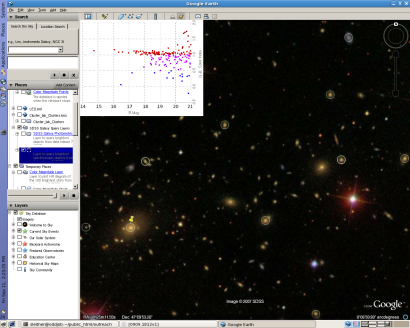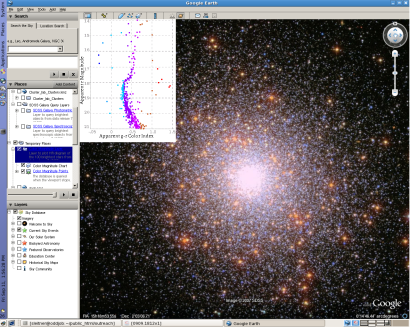
For our labs, the Sky layer has be supplemented by user-generated plugins written in a simple markup language called KML. The plugins can add interactive features and images to the Sky environment. Plugin development has become central to our lab creation efforts because plugins allow Sky to draw on external databases, like the SDSS, so that students can easily engage the data.
To load a given plugin the user should start Google Earth, load the sky layer and then go to file->open in the drop down menu and browse for the file. Most plugins are only activated when the viewport stops so, after loading, you have to pan and stop again before the plugin will become active.
SDSS Galaxy or Star Query Plugin -- Based on Simon Krughoff's SDSS plugin (available here), it queries for galaxies or stars in the field of view from the SDSS spectroscopic and photometric database, circles them and provides information in a pop-up window, including a link to spectrum if available.
(Note: the Galaxy Spectrum Query in the "Galaxy Query Plugin" is currently set to return spectra for all objects in the SDSS because object identification is unreliable. From the image context it is usually clear what the spectrum pertrains to.)

SDSS Galaxy Color-Magnitude or Stellar HR Diagram Plugin -- Queries galaxies in the field of view from the SDSS database and displays their color-magnitude diagram.


Note: popup and circled galaxies are from the Query plugin graph in left is from the HR/CMD plugins .
The following table contains a number of undergraduate labs.
| Introduction to Google Sky
(PDF/TeX)
|
Basics of Sky: The surveys included and a quick reference. |
some coordinates |
| The HR Diagram
(PDF/TeX, Image)
|
Stellar Populations: Explore the HR Diagram of Open Clusters, Dwarf Spheroidals, and Globular Clusters in the SDSS, and of field stars in Hipparchos. |
SDSS Star Query, SDSS Stellar HR Diagram, Hipparcos Star Query and Hipparcos-HR (thanks to James Stafford). Locations: Open Clusters, Dwarf Spheroidals, and Globular Clusters. |
| Hubble Lab: Morphological Types, Spectra of Galaxies, and the Hubble Expansion Law
(PDF/TeX, Image)
|
Constructing the Hubble Diagram: Measure distance from Brightest Cluster Galaxy photometry, and redshifts from galaxy spectrum. Homogeneity of Space: Show that Galaxy counts are a Poisson distribution on large enough scales. Scales listed in the lab are too small for Poisson statistics. See next lab below for an extension. Understanding Spectra: Explore the general shape of spectra for various morphological types. |
SDSS Galaxy Query w/o redshifts displayed and SDSS QSO/Star Spectra Query Locations: BCGs and random fields |
| Homogeneity with Magnitude Limits
(PDF/TeX)
|
Extension of the homogeneity exploration in the Hubble lab above. |
SDSS Galaxy Query by R-Magnitude Bins |
| Galaxy Environments, Clusters of Galaxies, and Dark Matter
(PDF/TeX)
|
Galaxy Environments: Field galaxies, colors and luminosities Clusters: Properties and cluster finding Dark Matter: Cluster masses from the virial theorem |
SDSS Galaxy Query and Galaxy Color-Magnitude Diagram.
Locations: Clusters, Groups, and Fields (same fields as hubble lab),
|
 Back to Sam Leitner's Homepage
Back to Sam Leitner's Homepage